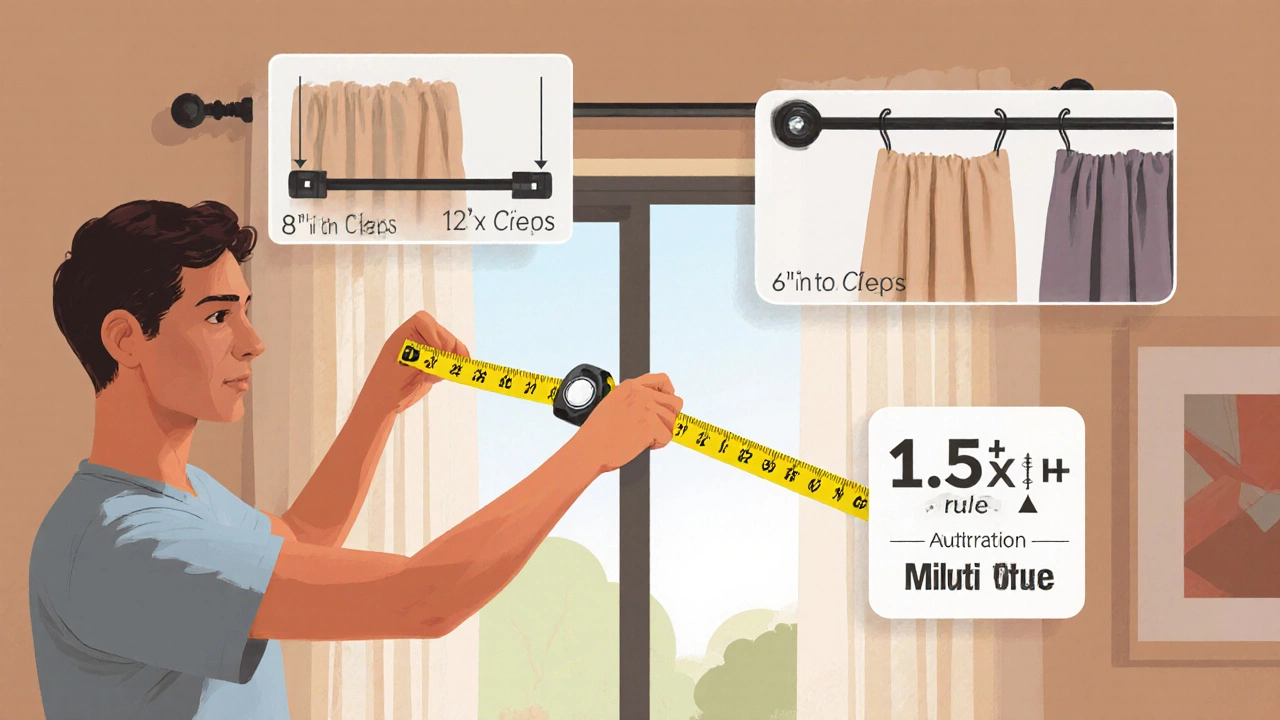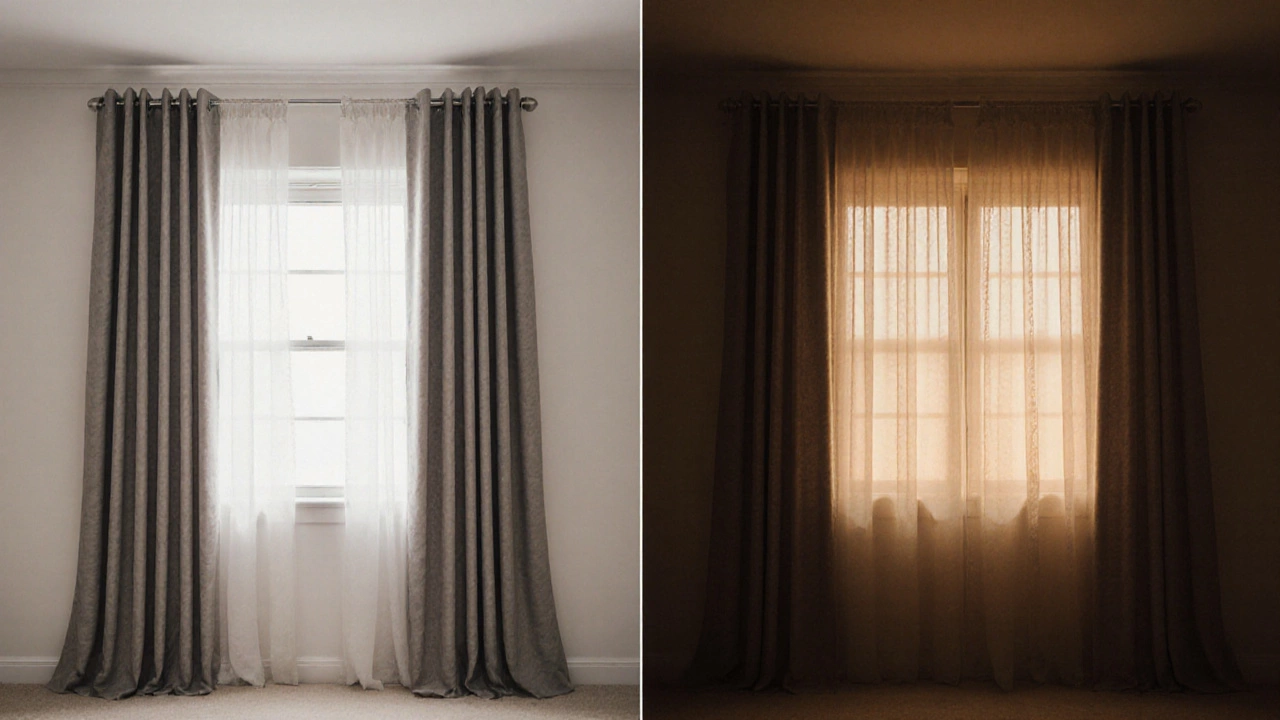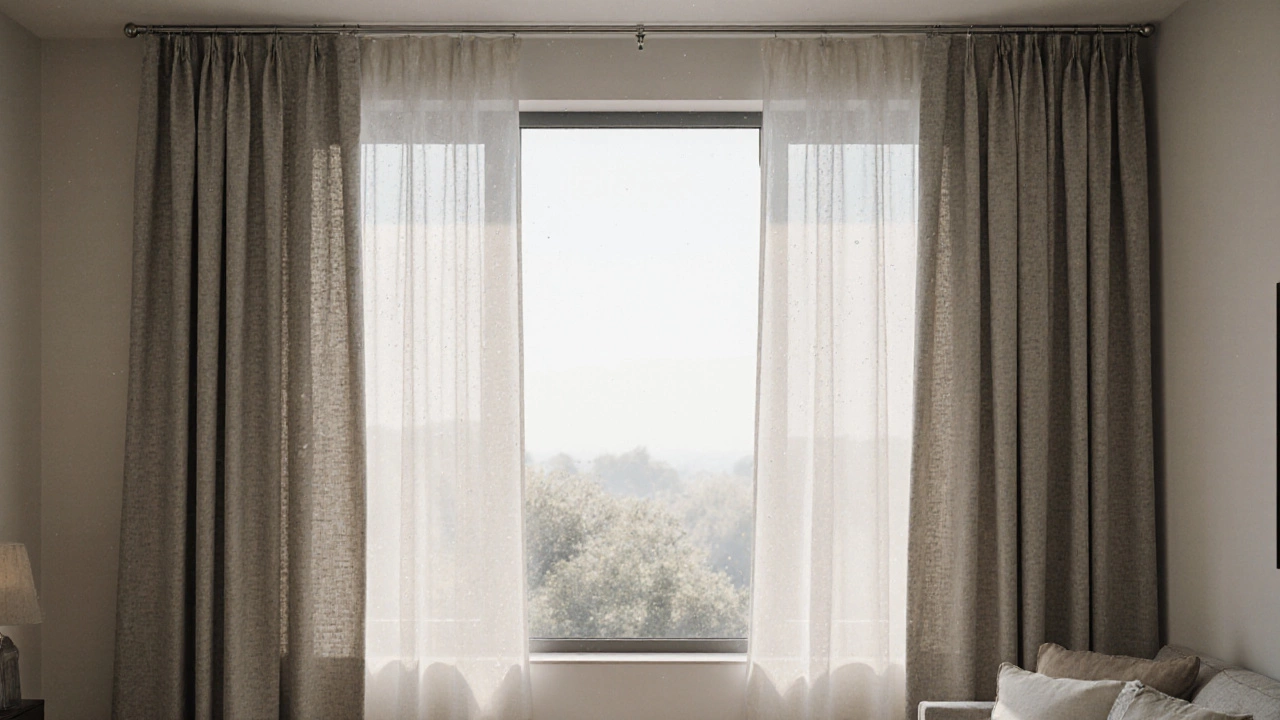Curtain Extension Calculator
Measure Your Window
Your Perfect Curtain Width
total inches (including extension)
inches extension per side
For fabric:
When you hang curtains, the goal isn’t just to cover the window-it’s to make the whole space feel bigger, brighter, and more put-together. Too short, and your windows look like they’re shrinking. Too wide, and you’re wasting fabric, money, and visual balance. So how many inches should curtains extend past the window? The short answer: curtains should extend 8 to 12 inches past each side of the window frame. But why? And when should you go longer or shorter? Let’s break it down.
Why Curtain Width Matters More Than You Think
Most people focus on the drop-the length from rod to floor-but the width? That’s where the magic happens. Curtains that barely cover the window look like an afterthought. They make the window feel smaller and the room feel cramped. When curtains extend past the window, they create the illusion of a larger opening. It’s a trick interior designers have used for decades.
Think about it: if your window is 48 inches wide, and your curtains only cover 50 inches total, you’re barely covering the sides. But if you go to 72 inches total-adding 12 inches on each side-you’re framing the window like a picture. Light flows in naturally, and the room feels more open.
There’s also a practical reason. When you pull curtains open, you want them to fully clear the window so sunlight isn’t blocked by fabric. If they’re too narrow, you’re stuck with half-light and awkward gaps. That’s why professionals always recommend going wider than the window.
The 8 to 12 Inch Rule-And When to Break It
Eight to twelve inches past each side is the sweet spot for most homes. It works for standard windows, sliding glass doors, and even bay windows. But there are exceptions.
If you have a large window or a floor-to-ceiling window, go for 12 to 18 inches past each side. This creates drama and elegance. Think of high-end hotels or luxury homes-they don’t skimp on width. The extra fabric pools slightly at the sides, adding texture and depth.
On the flip side, if you’re working with a small window in a tight space-like a bathroom or narrow bedroom-stick to 6 to 8 inches. You don’t want curtains to stick out too far and hit a door or lamp. In tight spots, function trumps flair.
Here’s a quick trick: measure your window width. Multiply it by 1.5. That’s your minimum total curtain width. For example, a 40-inch window needs at least 60 inches of curtain fabric total. That gives you 10 inches of overlap on each side-right in the ideal range.
How to Measure Correctly (No Guesswork)
Measuring wrong is the #1 reason curtains look off. Don’t just eyeball it. Here’s how to do it right:
- Measure the exact width of your window frame-from inside edge to inside edge.
- Decide where you’ll mount the curtain rod. For the best effect, mount it 4 to 6 inches above the window and extend it 4 to 6 inches beyond each side of the frame.
- Now, add 8 to 12 inches to the total window width for curtain overlap. That’s your target curtain width.
- Buy curtains that match or exceed that number. Don’t settle for less.
Pro tip: If you’re using a tension rod or a rod with decorative finials, account for the extra width those add. A finial that sticks out 3 inches on each side means you can get away with slightly less fabric overlap.

What Happens If You Get It Wrong?
Too narrow? You’ll notice it right away. Light leaks in at the sides, the window looks smaller, and the curtains look like they’re fighting for space. In photos, it’s the #1 sign of amateur decorating.
Too wide? You might end up with excess fabric pooling on the floor or bunching awkwardly when open. It’s not a disaster, but it can look messy if the fabric is heavy or stiff. That’s why fabric choice matters. Lighter materials like linen or cotton can handle more width without looking bulky. Heavier velvets or blackout fabrics? Stick closer to 8 inches unless you’re going for a grand, dramatic look.
One real-life example: a client in Fremantle had a 60-inch window and bought 70-inch-wide curtains. The result? The curtains barely covered the sides. When she pulled them open, half the window was still blocked. She replaced them with 96-inch panels. Instant upgrade. The room felt 20% bigger.
Fabric Weight and Curtain Stack-Up
Heavier fabrics take up more space when gathered. A thick velvet curtain might need 15 inches of overlap on each side to look full and not scrunched. Lightweight sheers? 6 inches might be enough.
When curtains are drawn, they stack up against the wall. That’s called the stack-back. A good rule of thumb: for every inch of curtain width, you need about 1/4 inch of stack-back space. So if your total curtain width is 96 inches, you need about 24 inches of wall space on each side for them to stack neatly.
If you don’t have that space, go for a narrower width or use a traverse rod that pulls curtains straight back. Or, consider a Roman shade paired with a sheer curtain for a cleaner look.

Common Mistakes and How to Avoid Them
- Mistake: Buying curtains based on the window size only. Solution: Always add 8-12 inches per side.
- Mistake: Mounting the rod too low. Solution: Hang it 4-6 inches above the window to make the ceiling feel higher.
- Mistake: Using one pair of curtains for a wide window. Solution: For windows over 80 inches, use two panels. It opens and closes more smoothly.
- Mistake: Ignoring the wall space. Solution: Make sure you have enough room for the curtains to stack back without hitting furniture or lights.
Real-World Examples from Australian Homes
In Perth, many homes have large sliding glass doors leading to patios. These need wide curtains to balance the scale. A 180-inch wide door? We use 240-inch wide panels-30 inches past each side. It creates a seamless transition from indoor to outdoor.
On the other hand, a small 30-inch bathroom window? Six inches past each side is plenty. Too much fabric here feels overwhelming and traps moisture.
Even in older homes with narrow windows, extending curtains past the frame makes the space feel intentional. A 24-inch window with 10-inch overlap on each side looks like it belongs in a design magazine-not a rental.
Final Checklist: Curtain Width Done Right
Before you buy or hang curtains, run through this quick checklist:
- Window width measured? ✔
- Curtain rod mounted 4-6 inches above frame? ✔
- Curtains extend 8-12 inches past each side? ✔
- Total curtain width = window width + 16-24 inches? ✔
- Enough wall space for stack-back? ✔
- Fabric weight matches the width? ✔
Get these right, and your curtains won’t just cover your windows-they’ll elevate your whole room.
Do curtains need to touch the floor?
Curtains don’t *have* to touch the floor, but they look best when they do-or just barely hover 1/2 inch above it. Pooling (extra fabric on the floor) works with heavy fabrics like velvet, but can look messy with lightweight materials. For a clean, modern look, aim for just brushing the floor.
Should I measure the window or the curtain rod?
Always measure the window frame first, then decide where to mount the rod. The rod should extend beyond the window, so your curtain width should be based on the *total space* the rod covers-not just the window. For example, if your window is 40 inches wide and your rod extends 10 inches past each side, your curtain width should be at least 60 inches.
Can I use curtains that are too wide?
Yes, but it depends on the fabric and space. Extra-wide curtains look luxurious with light, flowing fabrics. With heavy materials, too much width can cause bunching and make the curtains hard to open. If you’re unsure, go one size up and test how they hang before cutting or hemming.
What if my window is asymmetrical?
For asymmetrical windows-like one next to a wall or corner-extend the curtain on the open side only. You don’t need to match both sides. The goal is to frame the window, not force symmetry. Just make sure the curtain clears the window fully when open.
Do I need two panels for a wide window?
For windows wider than 80 inches, two panels are almost always better. One panel can be too heavy to pull smoothly and may sag in the middle. Two panels open evenly and look more balanced. Plus, you can choose different patterns or textures for each side if you want a custom look.
